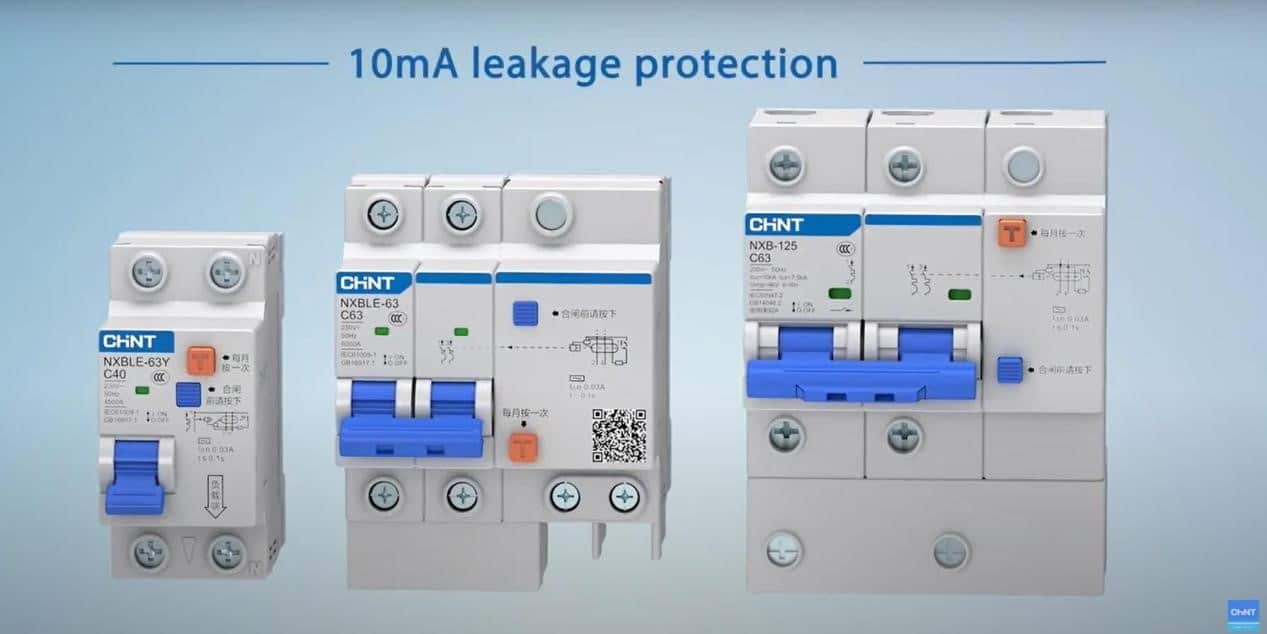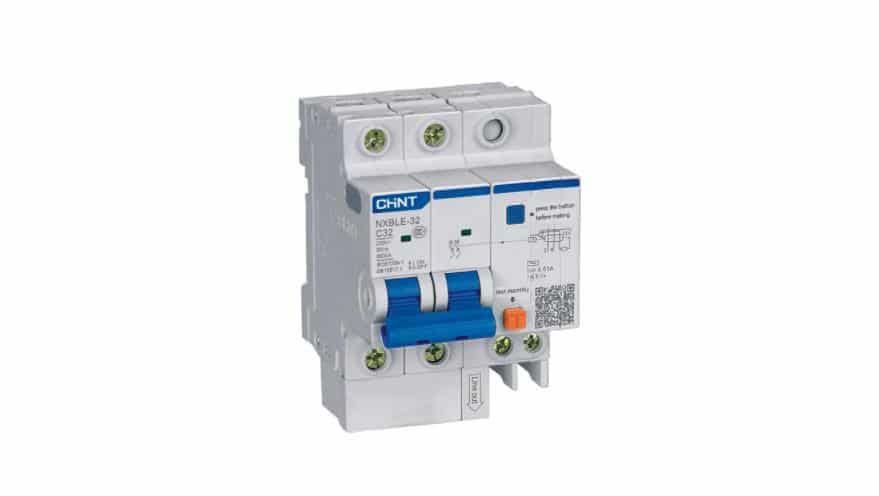Table of Contents |
An RCBO, or Residual Current Circuit Breaker with Overload protection, is an essential device for protecting people and property from electric shocks, fires, and other electrical faults. They come in different types and offer advantages, such as detecting imbalances in current flow and shutting off the power before damage can occur.
RCBOs are commonly used in residential and commercial settings and are becoming increasingly popular due to their ability to provide both overcurrent and earth fault protection in one device. When choosing an RCBO for your home or business, it is important to consider the type of device, the level of protection required, and the environment in which it will be used.
Keep reading to learn more about RCBOs, how they work, and their different types.
What are RCBOs?
An RCBO (residual current circuit breaker with overload protection) is a device that combines the functions of an RCD (residual current device) and an MCB (miniature circuit breaker) in one unit. It is designed to provide protection against electrical hazards in both residential and commercial settings.
RCBOs are installed in the electrical distribution panel and act as the main point of contact for the electricity supply. They work by constantly monitoring the current flowing through the circuit. If there is an imbalance, such as an earth fault, the RCBO will trip and shut off the power, preventing damage to people and property.
While RCDs only provide protection against earth faults, MCBs only protect against overcurrent, such as those caused by an overload or short circuit. By combining these two functions in one unit, RCBOs are a more efficient and cost-effective solution for circuit protection.
RCBOs are designed to detect even the smallest of current imbalances and trip the circuit breaker before any damage can occur. This makes them an essential safety feature for both residential and commercial properties. They provide protection against electric shocks, fires, and other electrical hazards that can occur due to earth faults, overloads, or short circuits.
How Does an RCBO Work?
An RCBO, or residual current circuit breaker with overcurrent protection, is a type of circuit breaker that is used to protect people and property from electrical faults. When an imbalance or fault is detected in the current flowing through an electrical circuit, the RCBO will trip and shut off the power, preventing damage from occurring.
RCBOs use a combination of sensors and electronics to detect imbalances in the current flow. These sensors are designed to detect even the smallest of current imbalances and trip the circuit breaker before any damage can occur. The RCBO also includes an overcurrent protection function that will trip the circuit breaker if the current exceeds a certain level.
ChintGlobal.com offers different types of RCBOs with different specifications, such as DZ-, DZLE-, DZLE-, DZLE-, DZLE- and DZLE-. These RCBOs have a wide range of breaking capacities and can be used in various applications. The DZ- RCBO, for example, is suitable for use in residential and commercial settings, while the DZLE- is ideal for use in industrial environments.
An RCBO is a vital part of any electrical system as it provides protection against faults and overloads. If you are looking for an RCBO, make sure to check out ChintGlobal.com for all your needs.
RCDs vs. MCB vs. RCBO
RCDs, MCBs, and RCBOs all serve different functions in circuit protection. RCDs detect and trip on earth fault currents, while MCBs protect against overloads. RCBOs, on the other hand, provide both earth fault and overload protection.
Now that we know the three main types of circuit breakers, let’s take a closer look at each one.
RCDs are used to protect against earth faults. They work by constantly monitoring the current flowing through the live conductor. If there is an imbalance between the live and neutral conductors, it means there is an earth fault. The RCD will then trip, breaking the circuit and preventing electrocution.
MCBs are used to protect against overcurrents. They work by constantly monitoring the current flowing through the circuit. If the current exceeds the MCB’s rated value, it will trip, breaking the circuit and preventing damage to electrical equipment.
RCBOs are used to provide both earth fault and overcurrent protection. They work by constantly monitoring the current flowing through the live conductor. If there is an imbalance between the live and neutral conductors, it means there is an earth fault.
The RCBO will then trip, breaking the circuit and preventing electrocution. If the current flowing through the circuit exceeds the RCBO’s rated value, it will also trip, breaking the circuit and preventing damage to electrical equipment.
RCDs vs. RCBOs
Both RCBOs and RCDs work by monitoring the current passing through a circuit and breaking the circuit if they detect an abnormal level of current.
RCDs are designed to protect against earth faults, which occur when the current passing through a circuit is not balanced. An imbalance can happen if there is a break in the circuit, or if one wire in the circuit becomes loose and begins to arc. RCDs can also provide some protection against overloads, but they are not designed to deal with short circuits.
RCBOs, on the other hand, provide both earth fault and overload protection. This makes them ideal for use in circuits that are likely to experience either type of problem. However, RCBOs can be more expensive than RCDs, so you will need to weigh up the relative costs before deciding which type of device is right for your needs.
RCBOs vs. RCCBs
RCBOs and RCCBs (residual current circuit breakers) both detect earth fault currents.
RCBO vs. MCB
While MCBs offer protection against overcurrents, they do not provide the same level of protection against earth faults as an RCBO. This is because MCBs are designed to protect the wiring and electrical equipment from damage caused by overcurrents, and will trip the circuit breaker when the current exceeds a certain level. However, they do not offer protection against earth faults, which is why they are often used in conjunction with an RCD or RCBO.
How to Select the Right RCBO
When selecting an RCBO, it is important to consider factors such as overcurrent characteristics, basic applications, tripping characteristics, and unwanted tripping.
Overcurrent Characteristics
The most important factor in choosing the right RCBO is the correct sizing for the application and equipment that it will be used on. An RCBO must have a rated current that is greater than or equal to the sum of the currents of all conductors that can be connected to it.
The overcurrent characteristic of an RCBO is defined by its class. The three classes available are A, B, and C. Class A RCBOs are used for low-level overcurrents, while class B RCBOs are designed for medium-level overcurrents. Class C RCBOs are intended for high-level overcurrents.
Basic Applications
RCBOs can provide both selective (fault only) and non-selective (fault and no-fault) discrimination. Selective discrimination ensures that only the circuit with the fault is disconnected, while non-selective discrimination disconnects both the faulty circuit and any healthy circuits downstream of the fault. This can minimize service disruption and prevent unnecessary shutdowns.
Tripping Characteristics
It is also important to consider the tripping characteristics of an RCBO when selecting one for your circuit. The tripping curve of an RCBO determines how quickly it will trip when an overcurrent condition occurs. You should select an RCBO with a tripping curve that matches the needs of your application.
Unwanted Tripping
Finally, you should also consider the possibility of unwanted tripping when selecting an RCBO for your circuit. Unwanted tripping can occur if the RCBO is not properly sized for the circuit, or if there are other factors that can cause false alarms (such as loose connections).
Conclusion
RCBOs are essential for protecting people and property from electric shocks, fires, and other electrical faults. They provide protection against earth faults, overloads, and short circuits, making them a more efficient and cost-effective solution for circuit protection.
When selecting an RCBO, it is important to consider factors such as overcurrent characteristics, basic applications, tripping characteristics, and unwanted tripping. It is also important to check the safety rating of the device before purchasing and to be familiar with troubleshooting methods.
Remember to visit ChintGlobal.com for more information on RCBOs and other circuit protection products.





 What are RCBOs?
What are RCBOs?









